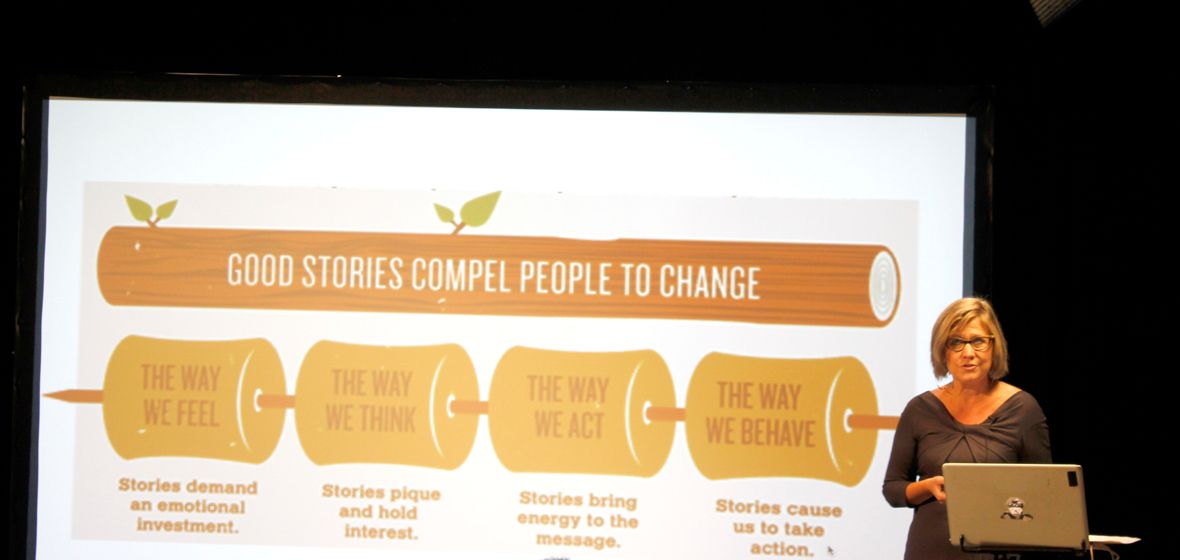It’s no secret that the media landscape is rapidly evolving. The increase in corporate storytelling, also known as brand journalism, as a means of establishing a brand identity is playing a large part in that change. Students, faculty and staff gathered together on Monday evening to listen to Jennifer Sizemore, Starbucks senior communications and marketing team leader, talk about her experience in helping corporate communicators tell authentic stories through brand journalism.
Sizemore’s unique background in news production, both in print and digital, is part of how she came to bring embedded newsrooms into nonprofits and later Starbucks. Sizemore created her first brand newsroom during her time as Vice President of Marketing and Communications at Fred Hutchinson Cancer Research Center. The newsroom’s purpose was to expand reach, brand recognition and the spread of quality information about the news closest to the heart of the organization. It worked.
That was in 2012. Fast-forward five years and the use of brand journalism for companies big and small has skyrocketed. During her talk, Sizemore touched on the controversial nature of brand journalism posturing that, while on its face it might seem less transparent, it could actually be more transparent in addition to being good for storytelling beyond a brand’s bottom line.
How can brand journalism be more transparent? According to Sizemore, companies and nonprofits would have built-in “firewalls,” or checks and balances in place, similar to that of news organizations where transparency and disclosure of financial information would be paramount to its success.
For Sizemore, brand journalism isn’t about writing about the brand directly. Instead, it’s about highlighting the communities that make these brands work, the issues that the company’s audience cares about and above all sharing stories that make an impact.
“These are Starbucks stories, but they aren’t about Starbucks,” Sizemore said during her lecture. “They’re about issues and people. With this kind of work, we can show how corporate storytelling doesn’t have to be about the brand, but instead about the people and causes that make the brand work.”
Sizemore admits her approach is idealistic, the concerns of Reynolds School faculty and students served for the start of a discussion surrounding the ethical concerns of brand journalism were poignant.
“Given the rapid pace of change in today’s media world, it’s important that we keep current with the latest developments in the field,” Dean Al Stavitsky said. “Jennifer Sizemore’s visit highlighted the rise of corporate storytelling, and she graciously engaged in discussion with the Reynolds School community of the practical and ethical issues it raises.”
Sheila Peuchaud, assistant professor of strategic communication, delved into what makes corporate storytelling different from traditional journalism when Sizemore visited her media ethics class. Students in Peuchaud’s class are learning that the purpose of journalism is to inform citizens so that they can be free and self-governing. While it’s not that corporate storytelling cannot similarly fill that role, according to Peuchaud, the audience occupies a different role as a consumer than as a citizen.
“With the way that Sizemore envisions corporate storytelling for Starbucks, it’s entirely possible that corporate storytelling can be done in an ethical manner,” Peuchaud said. “I think that both can be done in a way that’s loyal to your audience and essentially truthful, but what’s the underlying point and purpose? That’s where I see the biggest difference.”
While it remains to be seen how companies and organizations will distinguish brand journalism from its traditional counterpart, the fact remains that if students are interested in careers in telling stories that make an impact brand journalism does create more job opportunities that did not exist before.
“One of the many benefits of Jennifer Sizemore’s visit was her willingness explain her vision of how the concept is being pursued at Starbucks,” said Caesar Andrews, Leonard Distinguished Professor in Ethics and Writing. “Students are now better able to assess corporate-based coverage, as they think about their job prospects. And they are better able to debate the authenticity of corporate journalism compared to traditionally independent journalism. ”
While there may not have been clear answers to every question, audience members were treated to an inside look at one of the largest evolving segments of the communications field, and also gained insight into the work that remains to be done.
For more information about the Reynolds School and its undergraduate or graduate programs visit journalism.unr.edu.












